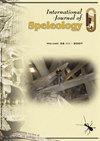磷酸盐结核的地球化学,作为了解旧石器时代洞穴遗址沉积和埋藏环境的工具(西西里岛圣特奥多罗)
IF 1.3
4区 地球科学
Q3 GEOSCIENCES, MULTIDISCIPLINARY
引用次数: 0
摘要
解释洞穴遗址的沉积环境通常是有问题的,尤其是在缺乏古生物学/考古证据的情况下。圣特奥多罗洞穴(西西里岛)的一些矿床就是这样,它是地中海旧石器时代的重要遗址。在被碳酸结核中断的地层水平中,磷结核仅存在于结核和洞穴壁之间的部分。这些结核的发现,加上化石的准时缺乏,最初表明了侵蚀现象,随后在包气水平上形成了结核。在这里,我们展示了一种综合的、地球化学的古生态学方法在定义地层学和古环境重建方面的有用性。XRD、ICP-OES、ATR-FTIR和EDS分析使人们能够就结核的起源、沉积动力学以及大量蝙蝠产生的鸟粪所起的作用提出一个新的假设。钡和铷在探测化学过程中的作用已得到强调。本文章由计算机程序翻译,如有差异,请以英文原文为准。
Geochemistry of phosphatic nodules as a tool for understanding depositional and taphonomical settings in a Palaeolithic cave site (San Teodoro, Sicily)
Interpreting depositional settings of cave sites is generally problematic, especially in absence of palaeontological/archaeological evidence. This is the case of some deposits at San Teodoro Cave (Sicily), a key site for the Mediterranean Palaeolithic. In a stratigraphic level interrupted by a carbonatic concretion, phosphatic nodules are present only in the part enclosed between the concretion and the cave wall. The discovery of these nodules combined with the punctual lack of fossils had initially suggested an erosion phenomenon and subsequent formation of nodules at a vadose level. Here we show the usefulness of an integrated, geochemical-palaeoecological approach in defining stratigraphy and palaeoenvironmental reconstructions. XRD, ICP-OES, ATR-FTIR and EDS analyses allowed the formulation of a new hypothesis regarding the origin of the nodules, the depositional dynamics, and the role played by the guano produced by an extensive colony of bats. The role of barium and rubidium in detecting taphonomical processes has been highlighted.
求助全文
通过发布文献求助,成功后即可免费获取论文全文。
去求助
来源期刊

International Journal of Speleology
地学-地球科学综合
CiteScore
3.10
自引率
23.10%
发文量
12
审稿时长
>12 weeks
期刊介绍:
The International Journal of Speleology has the aim to get cave and karst science known to an increasing number of scientists and scholars. The journal therefore offers the opportunity to all scientists working in and on karst to publish their original research articles or their review papers in an open access, high quality peer reviewed scientific journal at no cost. The journal offers the authors online first, open access, a free PDF of their article, and a wide range of abstracting and indexing services.
 求助内容:
求助内容: 应助结果提醒方式:
应助结果提醒方式:


